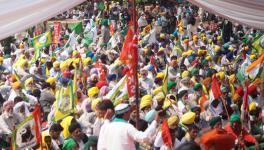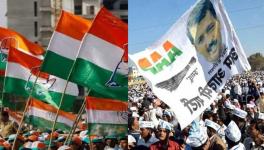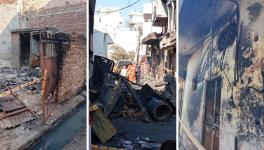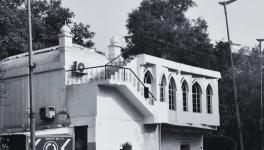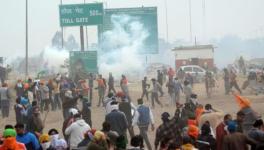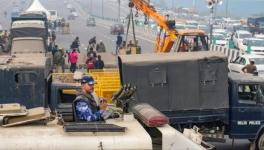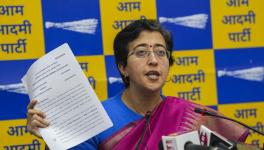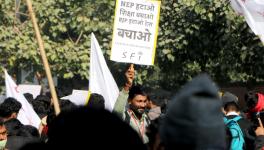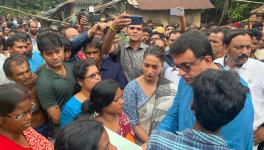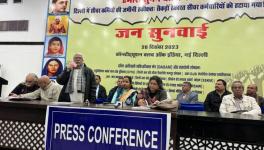Delhi Pollution: Odd-Even Formula will make it More Odd
Newsclick interviewed D.Raghunandan, member of Delhi Science Forum, on the issue of deteriorating environment in Delhi due to rise in pollution. According to him, government authorities lack the vision to curb pollution and bring it down to safer levels. Lack of planning in strengthening the public transport system, poor infrastructure development, along with inappropriate steps on development have led to a situation of chaos and increase in pollution. Development agendas often result in unplanned execution of projects without taking into account the extent of damage it causes to environment. Raghunandan argued that India has still not recognized the feasibility of non-motorised vehicles. Therefore, safety covers, which many developing countries have successfully understood and implemented, haven’t yet been provisioned for pedestrians and bicycle travelers, in India. Pollution checking cannot be successfully realized without carrying systematic changes in policies at the macro level. Unmindful implementation of policies is mere eye-wash.
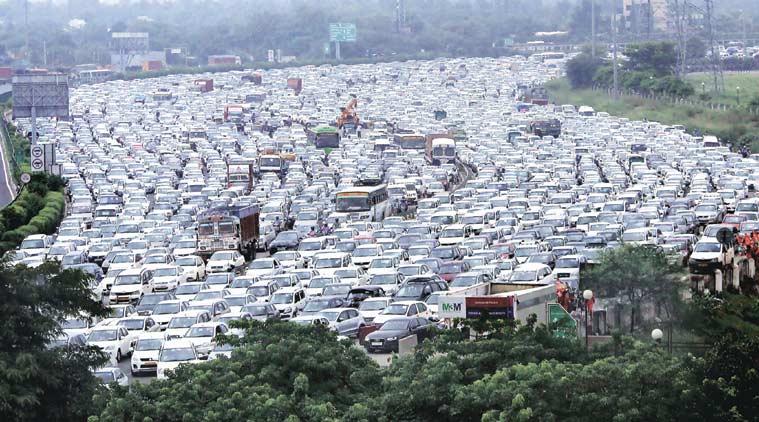
Image Courtesy: indianexpress.com
Rough Transcript:
Pranjal(P) - Hello and welcome to Newsclick. The pollution level in Delhi has reached an alarming situation. Supreme Court has stepped in and has given to various direction to different agencies. On the other hand, the Delhi government has taken measures like implementing Odd and Even numbers for vehicles on different days. To discuss the issue we have with us, D. Raghunandan from Delhi Science Forum.
First of all before going to the Odd and Even logic and the Supreme Court's directions, what actually the situation in Delhi in terms of pollution level?
D.Raghunandan(DR) - Well, the situation as you know and as you said in your introduction is very bad. Particularly as regards particulate matter, which is particularly bad and the Nitrogen Oxide which is at bad levels and Ozone which is not monitored as such but when you want to, you can monitor it and Ozone particularly add pedestrian level is actually quite high, which is a bi-product if you all like the other pollutants. So it is very bad and as you know Delhi has been consistently now over the past nine months or so been in the top 10 in the world, if not no1 or no2. We and Beijing seem to be chasing each other for the top spot in this. Primary cause of the pollution which accentuated in winter because of the cold air, everything settles down so there is a inversion as they called it involved and pedestrians and people are at ground level will feel it more. Primary cause is vehicles, duet pollution and particulate matter coming from biomass burning both in Delhi and surrounding country side around us. the problem is that all three will get intensified and magnified during winter.
P - So Raghu, when you talk about the biomass burning situation that is there in Delhi, vehicle problem, do you think there is a lack of planing on the part of government which is also lead to it? No proper implementation regarding setting up of industry around the city, so does it have a role to play in it?
DR - Of-course bad planning does but even deeper than that, there is a tendency to take very short term view of things. You do what do you think is workable for you today and you don't look down the road 4 years 10 years to see what possible consequences there are. Take the biomass issue for example. Every year Delhites now complaints that farmers in Punjab and Haryana are burning crop residues. Why they are burning crop residues? why it is not taking place in Madhya Pradesh or Rajasthan? In the green revolution areas, particularly in Punjab, use of combined harvests now very extensive. And when combined harvests going to a field, they don't leave a lot of post harvest residue, crop residue like straws, stocks, etc. which traditionally rural area would be used as a fodder and so on. The harvesters gets chops off everything that on top, leaving behinds stubs, which are too small for you to collect and use in any insensible way so what the farmers do, he sets fire to it to get rid of it. And Punjab is net importer of fodder because you have destroyed all the fodder by using combined harvesters. I think classic example of introduced a pattern of agriculture without thinking about what else it is going to do down the line and it's other consequences. We have done the same with vehicles.In Delhi, we have allowed our public transportation to be run to the ground till the metro came and it is just a few years old, frankly speaking still to make it's impact at Delhi level. We have allowed our public transport to get run down, which has encouraged people to buy more personal vehicles. We have now designed our roads, flyovers in a way as to provides for or if you look at it in other way, to encourage people to use. Look, we have built flyovers. So why don't you take advantage of that and use. Because the idea was we thought building flyovers means modern and we will build a world class city by building by world class flyovers. So you got world class pollution now.
P - Flyovers used to be in one of the points in manifesto actually.
DR - Thats right. We have done this and we have done that. And this started in the early 80s during the preparations for the Asian games and we haven’t looked back. So actually Delhi has got more mileage of roads in the city per million of population or per thousand population, than most metros in the world. We have got more roads than Paris, than London. It is unbelievable but true. And the reason is, because we now got so many cars, that you have run out of road space even with the road expansion to do that. Now you got pollution today.
P - If we leave aside Delhi, what is the situation in other big cities in India, just like Lucknow has been emerging as one of the most polluted capital in the country. So can you through some light on them?
DR - See, one is this broad structure of how you build roads and transportation. Delhi at least has taken some steps like introducing CNG in buses, in taxis and in auto-rickshaws, which makes big difference. Otherwise we would have had very polluting; two stroke engines driving the autos and polluting the diesel driving cars. Having done that however, on the other side we have encouraged diesel manufacturers to make models and sell them to private car owners for personal use. The idea used to be diesel was made cheaper, tax less so that it could be available for transport of essential commodities because you thought if you kept those fuels low, essential commodity's price would be lower. Now that privilege has been extended to personal car usage also. About a just decade ago, Delhi used to have only 3% of it's vehicles were diesel. Today the number has gone up to 25%. And 50% of new registrations in Delhi are of diesel vehicles. And the quality of the diesel we make in India is poor. The standards that we have for diesel pollution is Bharath Stage-4, roughly corresponding to Euro-4 standard, where today in Europe, you have got Euro-6 standard, which are three times or four times tighter. Now this is the position in Delhi. We, for example Delhi Science Forum have been campaigning for now close to eight years against allowing diesel vehicles to be used as personal vehicle. We have made a series of proposals. Government had appointed an expert committee, the previous government under the chairmanship of Kirit Parikh, who had recommended just like DSF recommended, of putting an up upfront price on diesel. People are using diesel vehicle today because the running cost is low. So we said, tax the diesel vehicle, make them about 1 lakh-1.5 lakhs more expensive than they are.. So at least there is a level playing field between diesel and petrol. That is also not done. So the car manufacturers have jumped in. Where there is a demand, there will be supply. This is the position in Delhi. But you go, you gave the example of Lucknow, Not more than 6 state capitals in our country have anything like an effective public transportation system. Couple of buses running around is about it. Most of them are private, they run wherever they want to run. There is no timing, there is no route. Then you are left with your auto type of vehicles. And in most small towns, cities including state capitals in the country, you have what are called Vickies, which are much more polluting, less energy efficient than even the petrol driven auto-rickshaws used to have. In many places, these are nothing but diesel generators mounted on a chassis and put into a vehicle and driven. Horribly polluting vehicles all over the city so while they may not have number of vehicles that we have in Delhi, the pollution that each vehicles will be causes several times more than what they are in Delhi. And if you don't provide public transport years to come, these will multiply. And recent studies also shown, that however efficient we made two wheelers, two wheelers today are major contributors. Two stroke engines are major contributors to pollution. And in smaller towns, people don't buy as many cars in Delhi, you will get motorcycles and scooters all over the place. Again more pollution. So I think that, we are going above our urbanisation completely in a wrong way in terms of pollution as well as in terms of fuel usage, as well as and significantly in terms of equity. By equity I mean, usage of energy, particularly costly, imported energy like fossil fuels and petrols products should be such that maximum number of people will derive the benefits. That is not happening today. It is all going to personal vehicles and personal vehicles are getting larger, luxury consumption is increasing. At same time, there are no buses, no viable public transport which basically means that rich are using more and more of the imported diesel for which all tax payers are paying through their nose. So if you use per capita of use of energy, the poor have virtually no access to motorised transport. If there are no buses, what will they do? The can't afford other forms like autos and stuffs like that. The roads the more and more we make them, they designed only for cars. They are not meant for cyclists, they are not meant for pedestrians, you can't use those but you are forced to. So in a sense we are dividing our country very sharply, increasing inequality, but the poor who spend most of their time outdoors commuting up and down are the one who suffers the most from the pollution.
P - Raghu, when you talk about the luxury cars and all that, recently Supreme Court gave a judgement that, for three months, none of such cars will be bought in Delhi. The Delhi government has come with Odd-Even formula. So what are these options and how feasible are they?
DR - Odd-even basically means that, depends on your number plate, if your number plate ends with even number, you will be allowed to travel three days in the week. If it is Odd number, you will be allowed to travel the other three days of the week. And everybody assumes that Sunday people will stay at home. So that is the formula. Many other countries have tried it. Most of the countries do it in particular day or for a particular period. For example. Beijing did it during the Olympics. Paris has done it before. Many countries do this. In London, they have imposed a congestion tax. On the inner part of the city, you can imagine Delhi is like a Lutyens zone and you can say any car entering the Lutyens zone, will be charged so much for entry like toll which discourage people from going. But in-order to any of the system to work, an alternative should be in place. If you tell me not to use my car, what do I do in those alternative days? I will use a taxi. That is also a car. It is going on to be on the road. More cars would be on the road, more autos will be on the road to cater to me unless you can actually increase the number of buses and make them more. Make public transport more efficient, make it more available. Personally, I believe that Delhi is not ready for that yet. We don't have that much public transport. Today, the metro carries something like 2.7 million passengers a day. Your bus service, however bad it is, with about four thousand buses currently running in Delhi carries three times as many people as the metro currently does. So you need something like at least ten thousand buses to be plying in Delhi in appropriate routes then you can say, we are offering an alternative to this then you need other measure to discourage a lot of motor cars, personal vehicle use. Your planing has gone completely hay wire, people are travelling long distances of 25, 30 or 40 Kilometres everyday to get to their place of work from place of residence. The plan decentralisation of workplace in Delhi has not taken place so everybody crowding around the districts. An even when buses ply on the road, you had this one poor experiment with BRT but rather than improving that and making a good, they have abandoned it. And now the Delhi government is saying, they are going to have dedicated left lane which is like BRT. If you are going to do it, do it but do it properly. My problem with current measures is while they are good in the sense indicate somebody is taking this seriously. And it has entered in the people's consciousness that, this has to be done. There are major protests in the road in Delhi yet against this Odd-Even formula, banning of diesel vehicles above so much cylinder capacity and so on which means people realise there is a problem and that we need to take steps. But I think if you take steps, you need to give people time. You have got this measure now about diesel vehicles. Large number of taxis in Delhi run on diesel. The so called DLY cars, private cars. OLA cabs and so on are yet to shift on CNG. There are lot of loopholes in the laws which enable people to do this. Vehicles which have all India permits but are actually travelling inside Delhi are bypassing. The laws using that routes. Whereas I think what we need to do is to give people are time framed. If you tell all taxi owners, we are giving you one year, face-out your diesel vehicle and switch, then I think easier on them, after all taxi owners are not exactly richest of the people. They also need time, they have invested money in these vehicles. They need to be able to sell the vehicles outside, etc. So give people time, build alternative framework and bring about the changes you need. You also need to make Delhi more cyclist friendly and more pedestrian friendly. The importance of non-motorised transport I think not been recognised in India at all, at any level by legislature, by administration, by judiciary, by anybody. You think roads are meant for cars. I remember talking to somebody I was in China, in one of their major city and they had this three lanes on either side, six lane roads. You had a BRT track then you had cycles tracks, then you had pedestrian track, then you had shops. And I was somebody about this and he said, " what, such a waste of space? " The point is, it is not the waste of space, it is a utilisation of space, segregated for different road users, which includes pedestrians, cyclists, lot of people in Delhi could walk hardly two kilometres or cycle kilometres if there was a safety. You have built cycle tracks, if you look at them, you will scooters, motor cycles, cars parked, khelas kept there. So cyclists comeback to the main road where is the most accident prone. In road accident in India, we kill the bulk of the people who are killed in the road accident either pedestrians and next are cyclists; which means you need to segregate those. So we need to plan comprehensively to encourage people to move away from personal vehicles, additional measures are taxation on vehicles. Singapore has extremely stringent rules for buying cars. If you want buy a car, you must first show that, you have a proper parking space. If you want to buy a second car, it will cost you two and half or three times what it cost you to buy the first car. So unless you are really rich and don't want to travel by the public transport, probably you won't buy a second car. You need to do all measures of that kind, address the issue comprehensively, holistically, look at the entire problem with a perspective, segregate your solutions according to different category users. Provide people alternatives to move away from personal vehicle and simultaneously disincentivise from people from buying or using personal vehicles through taxation, tolls, taxes, whatever other measures you want.
P - Thanks Raghu for giving us your time.
DISCLAIMER: Please note that transcripts for Newsclick are typed from a recording of the program. Newsclick cannot guarantee their complete accuracy.
Get the latest reports & analysis with people's perspective on Protests, movements & deep analytical videos, discussions of the current affairs in your Telegram app. Subscribe to NewsClick's Telegram channel & get Real-Time updates on stories, as they get published on our website.









